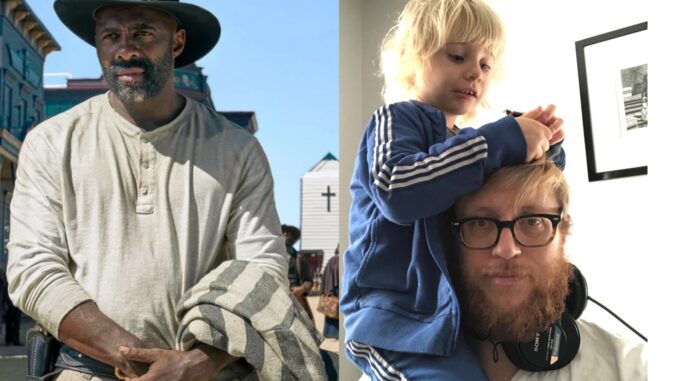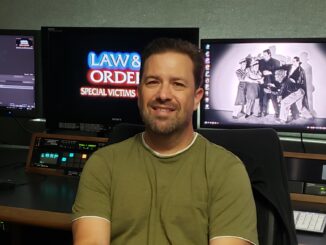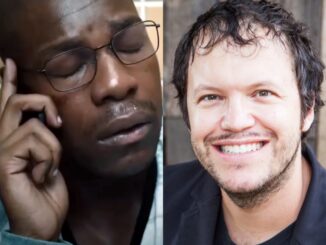
By Rob Feld
Tom Eagles attended an undergraduate film program in New Zealand but, with his school loans looking onerous, passed on an opportunity for a graduate program with his friends. Opting for the “real world,” he worked as a promo director while “doing film school on the sly,” helping friends on their film school productions and borrowing their cameras.
“A friend who was working as an assistant editor was working nights and whatnot, but it seemed like he was much more involved in the process of building a story; the real thing as opposed to just a piece about the thing,” he said. “I found the freedom of being able to create a story from footage really appealing. Doing promos was a great film school and I was getting good at them and respected in that field, but it wasn’t filmmaking.” Eagles made the switch and worked for a year as an assistant before he started cutting in his own right.
Eagles has since staked out a space for himself in the realm of tonal tightrope-walks, particularly with his frequent collaborations with Taika Waititi on projects like “Hunt for the Wilderpeople,” “What We Do in the Shadows” (with Jemaine Clement as co-director), and “Jojo Rabbit.” The film community in New Zealand is small and Eagles had met Waititi through his wife, hair and makeup designer, Dannelle Satherley. “I think he turned up at my house and I woke up and found him crashed out on my couch with some other reprobate actors and whatnot,” Eagles recalled. “It was that kind of house.” Eagles got to know Waititi while he hung around the house working with Satherley on the design of his film “Boy,” eventually coming to screenings, sharing thoughts, and cutting the film’s trailers. When it came time to cut “What We Do in the Shadows,” Eagles got the call to join Yana Gorskaya and Jonathan Woodford-Robinson as round-robin editors, passing the cut between them.
Eagles’s recent collaboration with director Jeymes Samuel, “The Harder They Fall,” marks another attempt to channel a unique voice, this time in the form of a Western with contemporary elements, from its music to its rhythm. The story follows outlaw Nat Love’s (Jonathan Majors) quest for revenge against Rufus Buck (Idris Elba), after Buck is released from prison. To tell the tale, Samuel takes people of color from real 19th century Western history and weaves them together to form two warring crews, where there are ultimately few winners. There are many characters, deep interpersonal dynamics, and a good deal of exposition for Eagles to track through the hyper-real, aestheticized film, and one can see him drawing on his past experiences to do so.
CineMontage: Is there a lesson that you learned from a mentor that you take with you to this day?
Tom Eagles: I’ve had a lot of mentors along the way. I think probably one of the first and most important was my script writing teacher, Shuchi Kothari. The first thing she told us is you’ve got to learn the rules to break the rules. Then you need to really know the medium that you’re working at before you decide to go out and be a rebel and turn everything upside down. The bulk of my training was script writing, which comes in handy when I’ve had to restructure stories, looking at character arcs and trying to figure out what the story’s all about. That training has stuck with me.
CineMontage: You have found these tonally unique films like “What we do in the Shadows,” “Jojo Rabbit,” or now “The Harder They Fall.” Is it a lot of trial and error with the director to find the voices?
Eagles: It is a bit of trial and error and a bit of just getting to know them. Taika Waititi is someone who I know well by now. “The Harder They Fall” was the first time I worked with Jeymes. My first meeting with him, he kind of sung the movie to me in parts. There’s a real musicality to the dialogue and real story in the music, with no boundary between them. Those things were kind of seamless in his mind. Then the challenge was how to make that real, and make sure that it had that feeling. I do get a lot out of the script and the dailies so you just have to be paying attention to what signals are being sent to you. It’s like the writer and the crew are playing in a certain key, and you need to pick up that key and run with it.
CineMontage: Did Samuel shoot in ways that conscribed your cutting?
Eagles: Not at all, no, but there was enough there to give me a vibe and a sense of what the movie could be. When you see an ultra-large close up of Regina King or just Idris Elba staring into the camera and you have a track like “Broader than Broadway,” I get a sense of the kind of crispness and directness of the communication happening. It is a process of trial and error. Like I did find with Jeymes, if I showed him two cuts and one was minimalist kitchen sink realism and another one was hyper-stylized, he would definitely go for the latter. But we found our feet pretty quickly, and it just worked. I can’t tell you how it worked. I think somehow he knew that we would click.
CineMontage: It’s hard to do that while collaborating across continents.
Eagles: It was always a wonderful surprise. For COVID-19 reasons, I was cutting the film in New Zealand for the first four months while they were shooting in Santa Fe. My crew was in LA. I would catch up with Jeymes on the weekends and show him what I’d been working on. At first, I was a little bit nervous because sometimes I would be going off script or pushing the boat out creatively to try and find the tone of the thing. But he always appreciated what I’d done to the point where he would later be defending my work against me when I thought we had to restructure or cut something down. He was a great defender of my first instinct.
CineMontage: Referencing the words of your writing teacher, you were working in the Western genre while integrating modern elements. What do you need to know about a genre before you can break it?
Eagles: That’s a really good question. I didn’t have a laundry list of what I was trying to learn but I did watch many Westerns and found myself drawn to the early color period — so the late ’50s — and then into the ’60s and ’70s, the new Westerns and the so-called Spaghetti Westerns. Those felt like they had the most resonance with the movie that we were making. It was about having that big library in your head. And Jeymes is like a walking encyclopedia of movies in general, but Westerns in particular. The inevitable pull of death and violence in a movie like “Pat Garrett and Billy the Kid” related to our movie, and we looked at [Sergio] Leone for the interplay of sound and music. If you think about the second scene in the movie, we lean on all of those spaghetti tropes; the ultra-close shot on the eye or hand twitching towards the holster. Jeymes always said that he was making this movie for people who love Westerns, but also for people who never watch Westerns. So, it was important to cast the net a little bit wider than that. We talked about “Magnolia,” we talked about Wayne Wang’s “Smoke.” “Magnolia” was about keeping the weirdness and stylistic flourishes — we wouldn’t cut the frog sequence out of “Magnolia,” which a lot of people would tell you to do.
CineMontage: What about “Smoke?”
Eagles: We have a couple of storytelling scenes in the movie, like the one Rufus Buck tells at the end. We actually had flashback material to cut into that but when I saw Idris’s performance come in, I really didn’t want to cut away from it. The only thing I wanted to cut away to was Jonathan, Nat Love, because it’s important to know what he understands when, and to see his response to that story. So, we talked about the storytelling scene in “Smoke” between Harvey Keitel and William Hurt. It’s just one long push-in on Keitel with a couple of cuts back to Hurt listening. But in my mind, I felt I had seen the story because it was so well told. I had illustrated it in the same way that I would if I was reading a good novel. So, going back and watching that scene gave us the confidence to ditch the flashbacks and stay with the performers. If you have a great storyteller telling a great story, you really don’t need anything else. I do love those moments in a movie where it just boils down to storytelling in a single performance. It’s a very Jeymes thing as well because he’s a great storyteller and a lot of his direction will come in the form of telling a story.
CineMontage: There’s much to learn from Westerns about how to build tension, as well.
Eagles: You have to understand how tension works generally, and in Westerns in particular. That was hard for some of the people involved in the filmmaking to know that sometimes we needed to stop the clock a little bit. Even in the church scene, there was pressure to just get through and get the story started, but we needed to linger in those moments to feel the tension. You know something bad is going to happen, you just don’t know exactly when or how. The train sequence was long so it’s all about pressure and release, when you play with music, dialogue, and sound. When Trudy is facing-off with the train, it’s all about sound and contrast, so I put a lot of work into the sound design, even before our sound designers came on, to try and give that contrast of this big slavering metallic beast, with her stopped still and silent. Then when we get into the train car, it’s playing on expectations. We know that there’s something at the end of the train, but we don’t know exactly what it is. Once we see that box in that last car, then we have time and opportunity to slow things down and eke out the tension.
CineMontage: Tell me about the split-screen moment. It’s an element that is only used once in the movie. Why that choice?
Eagles: I think it gives you a sense of the separation. There’s this barrier between these two worlds inside and outside that last car of the train; black and white, the law and the outlaw, ostensibly. You want to see both of those things happening simultaneously. You want to see everything that Cherokee’s saying, and the effect that it’s having inside the train carriage. You could have done it with cuts, but Jeymes was very clear early on that this was going to be split screen. It gives you a kind of disjuncture between what the General thinks is going on and the power he thinks he has, and what Cherokee is telling him, “We have your son. You’re going to open the door.”
CineMontage: Do you risk losing the audience’s eye splitting the screen?
Eagles: Absolutely. That’s very hard because normally, as any editor will tell you, you are directing the gaze. When you have two things up on screen, you’re gambling a bit. So sometimes I would use cutting to draw the eye over to the General’s side. Because LaKeith is so magnetic when he’s talking, your eye will travel to him naturally most of the time. But there are times you need to draw the eye across to the other side. A cut will do that.
CineMontage: How did you approach the exposition without breaking up the narrative too much?
Eagles: As first assembled, there was a little too much exposition and a lot of getting the two gangs set up against each other. The first two acts were chopping backwards and forwards between the two teams. It was just unsatisfying. I was watching a DVD of “The Godfather II,” with Walter Murch talking about how they had the same problem between the present day story — the Al Pacino story and the De Niro story — cutting backward and forwards in time. So, they boiled everything down and consolidated those into little stories of their own. So, we tried to do that somewhat with “The Harder They Fall,” and stay with one set of characters for longer. So, I pulled out almost all the Buck gang material from the first act, so you see the original sin and you meet Rufus Buck mysteriously, which was enough to set up the revenge tale and to hold that space until he’s busted off the train. There had been other scenes with that gang and with Rufus in prison as well, but I thought with so many characters, it was important to get the Love gang established first, and then wait until a little later to introduce the so-called bad guys.
CineMontage: Obviously, COVID affected your process, but did it have a creative impact?
Eagles: I think it did. And it worked to our favor, sometimes. There’s the bar scene when Nat comes and sees Mary performing, reuniting them after a long time. They couldn’t shoot that scene with a whole lot of extras because of Covid-19 restrictions. So, they had to think about, “How are we going to cover this in a way that doesn’t show that the room is completely empty?,” and they came up with these super tight close-ups. I think Jeymes was a bit disappointed — he wanted the vibe of a big party — but I found those close ups to be a gift. You got all these punctuation points of glasses smashing together or the card coming down on the table. And then, in the second half of the scene, we were able to create an intimate moment between Nat and Mary across the room: their eyes meet across the room and you get these super tight close-ups of eyes and lips, which has this sensuality. In a way, it’s a more intimate moment than the next scene where they’re alone together in the bedroom. I think that was a real gift.
CineMontage: You mentioned that Samuel would choose your most hyper-stylized option every time. When does style add to a movie and when does it detract?
Tom Eagles: I think on this movie, we ditched the dichotomy. We did not say that style is oppositional to substance. The style is a part of the soul of this movie. When we were cutting the movie down to time, we found that if you took out too much style, the movie lost some of its soul. So, it was just another ball to have in the air. We still had to do all of the things that you do to keep Nat Love’s anger and pain at the center of the story, and keep that performance grounded, while showing a little light in him, as well.
We worked hard to show a little charm and humor in his character, and to illustrate the relationship with Mary, so there was some sense of hope for him at the end of the movie. And to make Rufus Buck a complicated, mysterious, and ultimately shaded character. He has a lot of gray tones to him, as does the whole movie. Jeymes always said, “There aren’t really good guys and bad guys in this movie.” Viewed in one way, the movie is a tragedy. Rufus Buck and his team are trying to do something good, and the family conflict brings them down, in a way. So, style was an added layer but we still needed to make sure that the film was emotionally truthful and sometimes very earnest. Then, having these stylistic sequences or humor was a good counterpoint.
I don’t view the things as antithetical. “Jojo Rabbit” was a good lesson for me on that front, that these things can all support each other if done in the right way.






